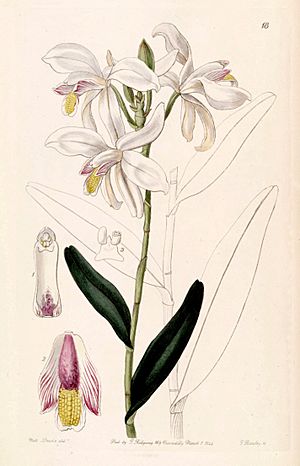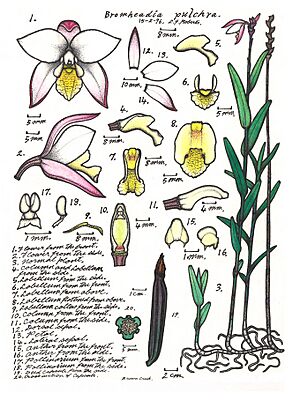Pale reed orchid facts for kids
Quick facts for kids Pale reed orchid |
|
|---|---|
 |
|
| Drawing of Bromheadia finlaysoniana (as B. palustris) by Sarah Drake | |
| Scientific classification | |
| Kingdom: | |
| (unranked): | |
| (unranked): | |
| Order: | |
| Family: | |
| Subfamily: | |
| Tribe: |
Vandeae
|
| Subtribe: |
Adrorhizinae
|
| Genus: |
Bromheadia
|
| Species: |
B. finlaysoniana
|
| Binomial name | |
| Bromheadia finlaysoniana (Lindl.) Miq.
|
|
| Synonyms | |
|
|
The Bromheadia finlaysoniana, often called the pale reed orchid, is a type of plant in the orchid family. In Australia, it is also known as Bromheadia pulchra. This orchid grows naturally in places from Indochina all the way to northern Australia.
It is a ground orchid, meaning it grows in the soil, not on other plants. It has a strong, upright stem and stiff, spreading leaves that are shaped like an egg. The plant produces a long stem for its flowers. Near the end of this stem, there's a short zig-zag part where single flowers open one after another. The flowers are white with a bright yellow labellum, which is a special lip-like petal.
Contents
What the Pale Reed Orchid Looks Like
The pale reed orchid is a ground-dwelling plant that stays green all year. It has flat, yellowish stems that can grow to be about 1 to 1.5 meters (about 3 to 5 feet) long. Its leaves are tough and spread out stiffly. They are shaped like an ellipse or an egg, measuring about 10 to 15 centimeters (about 4 to 6 inches) long and 2 to 3 centimeters (about 1 inch) wide.
The flowering stem, where the blooms appear, is usually about 10 to 20 centimeters (about 4 to 8 inches) long. At the very end of this stem, there is a short zig-zag section. Here, up to seventy-five white flowers can open one by one.
Each flower is about 3.5 to 4.5 centimeters (about 1.4 to 1.8 inches) long and 3 to 4 centimeters (about 1.2 to 1.6 inches) wide. The outside of the flowers often has a pinkish color. The sepals, which are like small leaves that protect the flower, are elliptic or egg-shaped. They are about 2.5 to 5 centimeters (about 1 to 2 inches) long and 0.7 to 0.9 centimeters (about 0.3 inches) wide. The petals are egg-shaped and are similar in length to the sepals, but they are wider.
The special lip-like petal, called the labellum, is a pale yellow color. It is about 2.1 centimeters (about 0.8 inches) long and 1.5 centimeters (about 0.6 inches) wide. This labellum has three parts, with the two side parts standing upright. In Australia, these orchids usually flower between June and March. In New Guinea, they can flower as late as October.
How the Pale Reed Orchid Got its Name
The pale reed orchid was first officially described in 1833 by a scientist named John Lindley. He originally named it Grammatophyllum finlaysonianum. He wrote about it in his book called The genera and species of Orchidaceous plants.
Later, in 1859, another scientist named Friedrich Miquel changed its name to Bromheadia Finlaysoniana. The second part of its name, finlaysoniana, was chosen to honor George Finlayson. He was the person who first collected the specific plant sample that scientists used to describe this species. This sample is called the type specimen.
Where the Pale Reed Orchid Lives
The pale reed orchid grows in many different places. You can find it in countries like Myanmar, Thailand, Cambodia, Laos, and Vietnam. It also grows in the Malay Peninsula, Singapore, Sumatra, Borneo, Brunei, the Moluccas, and New Guinea. In Australia, it grows in the Cape York Peninsula in Queensland, stretching from the very top down to Hopevale. It is also found in the Anambas Islands. There's a chance it might grow in the Philippines too, but scientists are not completely sure.
This orchid prefers to grow in wet areas, often close to streams. It can be found at low altitudes, from sea level up to about 200 meters (about 650 feet) high.
See also
 In Spanish: Bromheadia finlaysoniana para niños
In Spanish: Bromheadia finlaysoniana para niños


